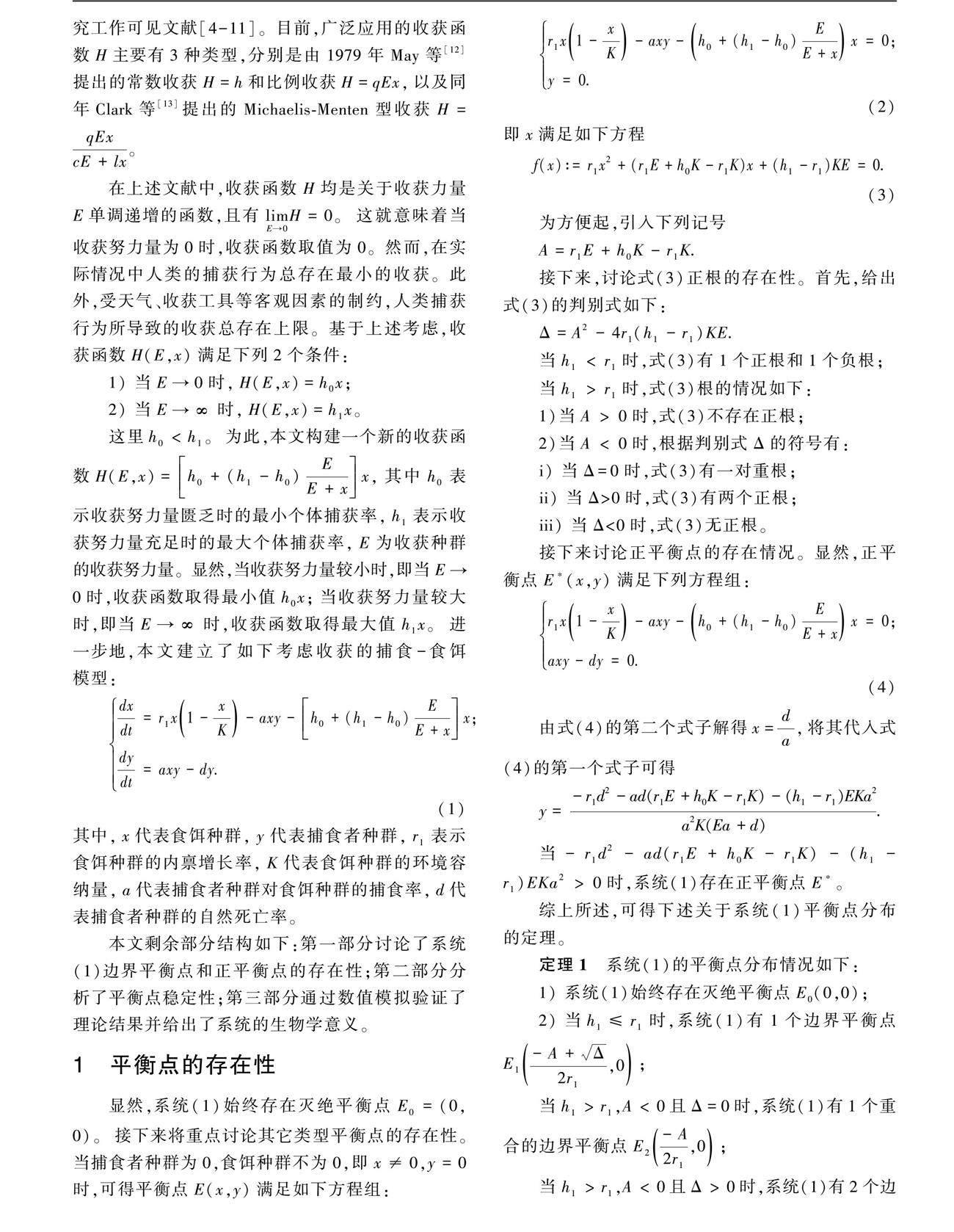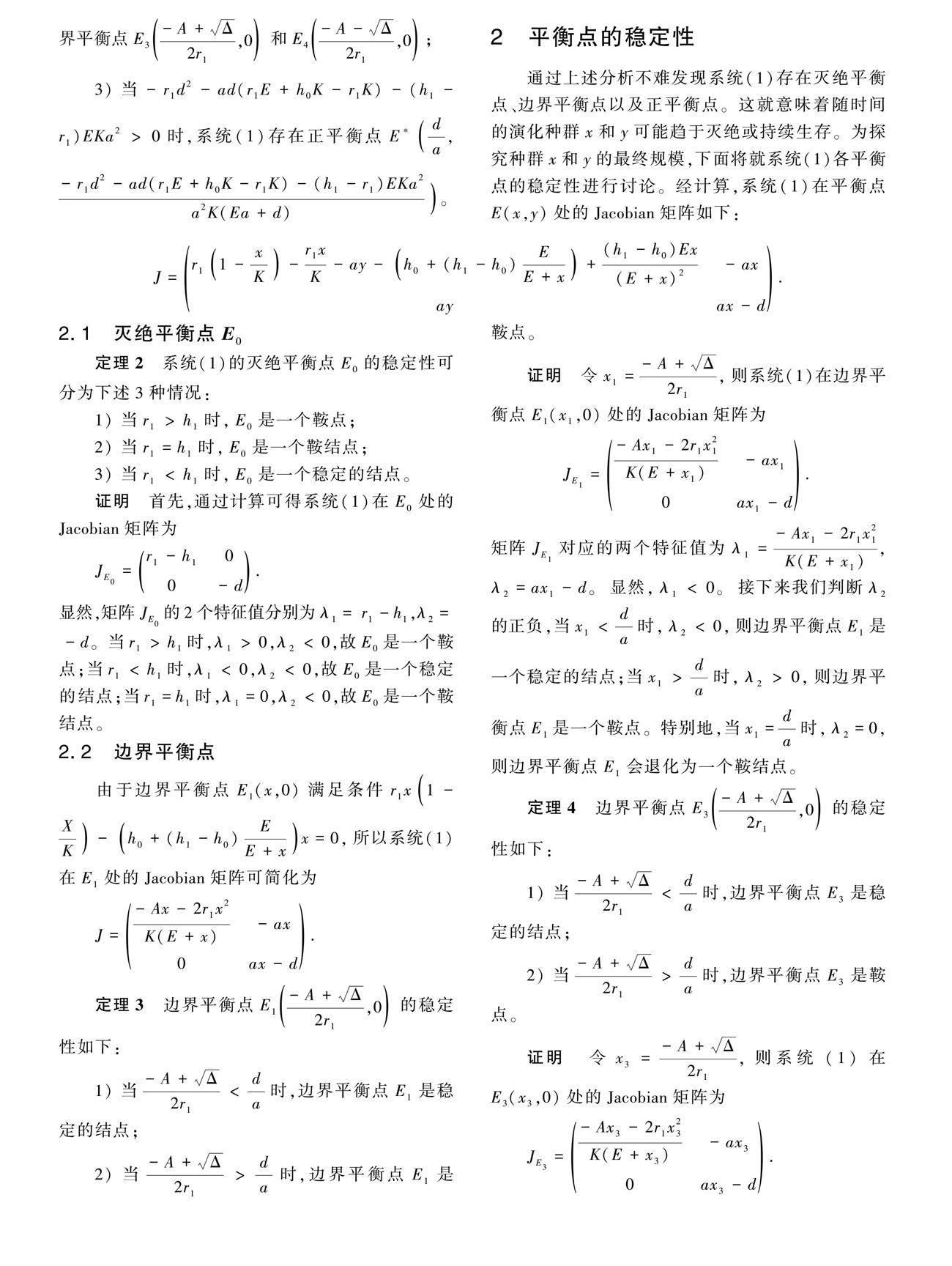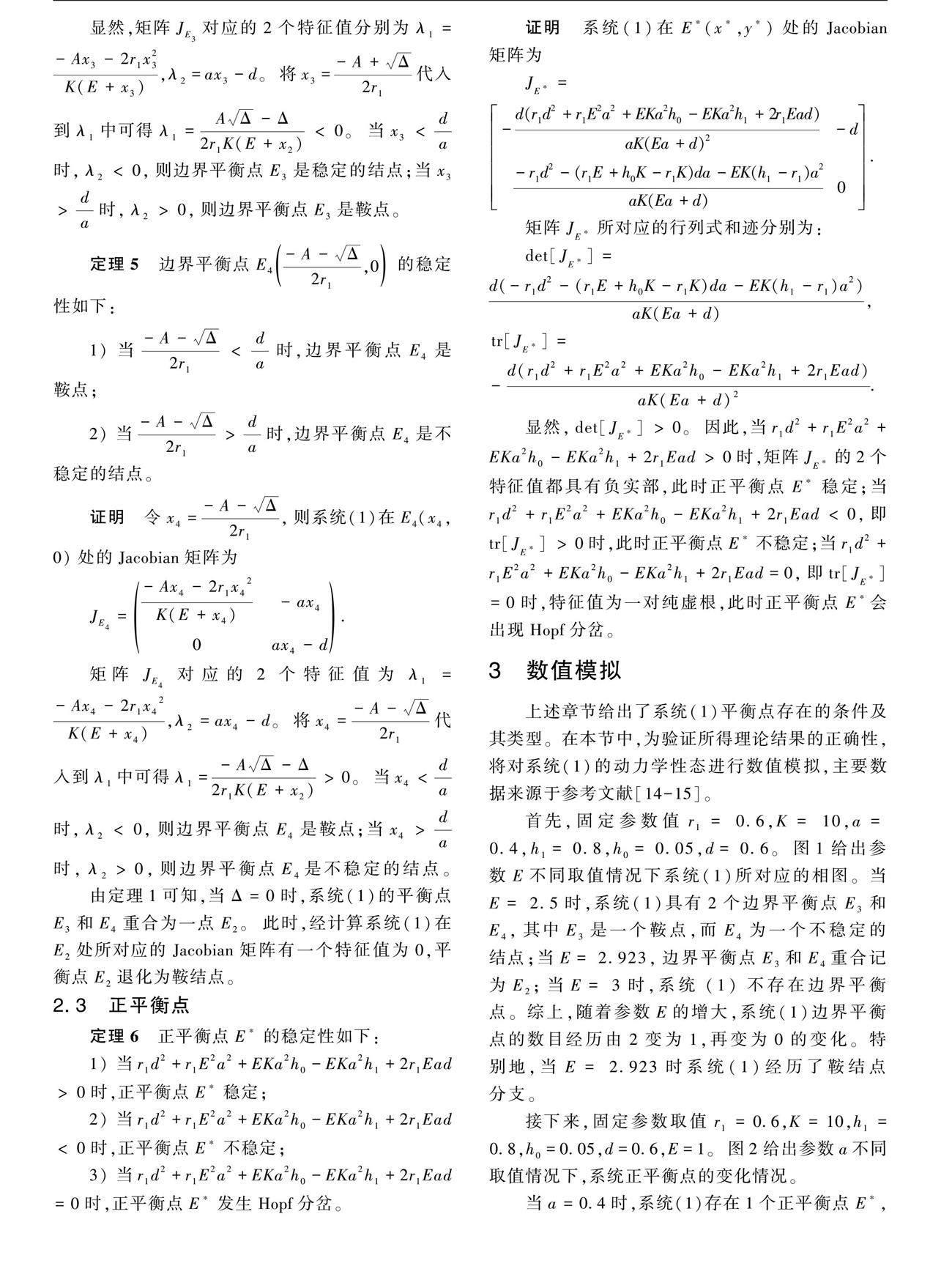具有非线性收获的捕食-食饵模型的建立及分析
张永鑫 罗航 李晓伟



摘要: 本文建立并分析了具有非线性收获函数的捕食-食饵模型。首先,讨论了平衡点的存在性,分析结果表明系统始终存在1个灭绝平衡点,且存在2个边界平衡点和1个正平衡点共存的现象;其次,对不同类型平衡点的稳定性进行了分析,发现了系统会出现鞍结点分支、Hopf分支等复杂的动力学行为。数值模拟结果表明,随着收获强度的改变,捕食者的规模会趋于灭绝、常数或者周期性震荡。这就表明在实际中可通过调节收获强度这一措施来实现控制捕食者数目的目的。本文的理论研究结果可进一步丰富有关具有非线性收获的捕食-食饵模型的研究,为合理收获策略的制定提供理论依据。
关键词:捕食-食饵模型;鞍结点分支;Hopf 分支;动力学行为
中图分类号: O175.1文献标志码:A文献标识码
Establishment and analysis of a predator-prey model considering nonlinear harvesting
ZHANG Yongxin,LUO Hang,LI Xiaowei
(School of Mathematics, North University of China, Taiyuan,Shanxi 030051,China)
Abstract: In this paper, a predator-prey model with nonlinear harvest function is established and analyzed. Firstly, we give the conditions for the existence of equilibria. The results of analysis show that this system has an extinction equilibrium, two boundary equilibria and a positive equilibrium. Then we focus on the dynamic behavior of this system and it is found that this system has complex dynamic behaviors such as saddle-node bifurcation and Hopf bifurcation. Furthermore, the numerical results show that the size of predators may go to extinct, constant or periodic oscillations, which depends on the intensity of harvest. This means that the number of predators can be controlled in practice by adjusting the intensity of harvest. The theoretical results of this paper can further enrich the research of predator-prey models, and provide theoretical basis for the formulation of rational harvesting strategies.
Key words: predator-prey model;saddle-node bifurcation;Hopf bifurcation;dynamics
捕食-食饵模型是生态学中的一个重要概念,用于描述捕食者和食饵之间的相互作用。在此类模型中,食饵是捕食者的食物,捕食者通过捕食食饵来获取营养和能量。在自然界中,捕食-食饵关系是普遍存在的,例如狮子捕食羚羊、鲨鱼捕食海豚、蛇捕食老鼠等。这种相互作用不仅影响捕食者和食饵的数量以及分布,还可能对整个生态系统的稳定性和演化产生深
远影响。
人类的收获活动可以干预到生态系统的平衡,合理的收获可以调节生态系统的稳定[1]。例如入侵我国的外来物种——美国白蛾,其适应能力强、繁殖量大、具有暴食性,严重影响了林木生长,甚至危害农作物,造成巨大的生态破坏和经济损失,被称为“无烟的火灾”。为此,国家通过采用人为捕获等措施,最终遏制了白蛾的繁殖,维持了生态系统稳定。然而,过度收获也会破坏生态系统的稳定。近年来, 由于过度收获导致物种灭绝的例子比比皆是[2-3],例如有“水中大熊猫”之称的白鲟,由于人类的大肆捕捞,最终在2019年12月正式宣告灭绝。因此,有关合理收获的研究事关生态系统的稳健性,具有极其重要的生物学意义。为此,本文将探讨一个考虑非线性收获的捕食-食饵模型,通过对该模型动力学行为的分析讨论收获行为对生态系统的影响。
关于收获在捕食-食饵模型中的作用的系列研究工作可见文献[4-11]。目前,广泛应用的收获函数H主要有3种类型,分别是由1979年May等[12]提出的常数收获H=h和比例收获H=qEx,以及同年Clark等[13]提出的Michaelis-Menten型收获H=qExcE+lx。
3 数值模拟
上述章节给出了系统(1)平衡点存在的条件及其类型。在本节中,为验证所得理论结果的正确性,将对系统(1)的动力学性态进行数值模拟,主要数据来源于参考文献[14-15]。
首先,固定参数值r1=0.6,K=10,a=0.4,h1=0.8,h0=0.05,d=0.6。圖1 给出参数E不同取值情况下系统(1)所对应的相图。当E=2.5时,系统(1)具有2个边界平衡点E3和E4,其中E3是一个鞍点,而E4为一个不稳定的结点;当E=2.923,边界平衡点E3和E4重合记为E2;当E=3时,系统 (1) 不存在边界平衡点。综上,随着参数E的增大,系统(1)边界平衡点的数目经历由2变为1,再变为0的变化。特别地,当E=2.923时系统(1)经历了鞍结点分支。
接下来,固定参数取值r1=0.6,K=10,h1=0.8,h0=0.05,d=0.6,E=1。图2给出参数a不同取值情况下,系统正平衡点的变化情况。
当a=0.4时,系统(1)存在1个正平衡点E*,2个边界平衡点E3和E4;随着a的增大,正平衡点E*逐渐向E3靠拢;特别地,当a=0.078时,正平衡点E*与E3合二为一,这就意味着系统(1)此时经历了一个鞍结点分支。
最后,固定参数取值为r1=0.6,K=10,a=0.5,h1=0.75,h0=0.1,d=0.3。当E=10时,如图3所示, 正平衡点E*为一个稳定的焦点,此时种群x和y的最终规模均趋于一个稳定的常数;当E=6时,如图4所示系统(1)存在一个稳定的周期解,此时种群x和y的最终规模呈现周期振荡。此时,正平衡点E*为一个不稳定的焦点。综上,系统(1)随参数E取值的变化经历了Hopf分支。
4 总结与讨论
本文建立并分析了一个具有非线性收获率的捕食-食饵模型。理论分析结果表明该系统存在边界平衡点、灭绝平衡点以及正平衡点共存的现象。特别地,随着收获率强度的改变,不同类型的平衡点的性态会发生变化,且模型会出现鞍结点分支、Hopf分支等一系列复杂的动力学行为。这表明改变收获率强度使得捕食者的数目趋于灭绝或者出现周期性震荡。
本文的理论结果可进一步丰富有关具有非线性收获率的捕食-食饵模型的理论研究成果,为合理收获策略的制定提供理论依据。
本文利用数值模拟的方法验证了其理论分析结果的正确性,未来可依据真实的实验数据对文中所涉及的参数取值进行修正以期更好地指导实际。
参考文献(References)
[1] TRAFFIC. Threats from over-consumption highlighted in IUCN Red List update[EB/OL]. 2018.http://www.trac.org/news/iucn-red-list-update-2018/.
[2] 刘慧. 第六次物种大灭绝正在进行[N]. 北京科技报, 2004-04-20.
[3] 苏孝同, 苏祖荣. 森林文化研究[M]. 北京: 中国林业出版社, 2012.
[4] WANG Y, ZHOU X, JIANG W H. Bifurcations in a diffusive predator-prey system with linear harvesting[J]. Chaos, Solitons & Fractals, 2023, 169: 113286.
[5] KASHYAP A J, ZHU Q X, SARMAH H K, et al. Dynamical study of a predator-prey system with Michaelis-Menten type predator-harvesting[J]. International Journal of Biomathematics, 2023, 16(8): 2250135.
[6] YAO Y, LIU L L. Dynamics of a Leslie-Gower predator-prey system with hunting cooperation and prey harvesting[J]. Discrete & Continuous Dynamical Systems-B, 2022, 27(9) :4787-4815.
[7] LIU W, JIANG Y L. Hopf bifurcation and singularity induced bifurcation in a Leslie-Gower predator-prey system with nonlinear harvesting[J]. East Asian Journal On Applied Mathematics, 2020, 10(1): 181-216.
[8] LAI L Y, YU X Q, HE M X, et al. Impact of Michaelis-Menten type harvesting in a Lotka-Volterra predator-prey system incorporating fear effect[J]. Advances in Difference Equations, 2020, 2020: 320.
[9] WANG L, ZHANG H, LIU S Y. On the existence of almost periodic solutions of impulsive non-autonomous Lotka-Volterra predator-prey system with harvesting terms[J]. AIMS Mathematics, 2021, 7(1): 925-938.
[10] WANG J M, CHENG H D, LIU H X, et al. Periodic solution and control optimization of a prey-predator model with two types of harvesting[J]. Advances in Difference Equations, 2018, 2018: 41.
[11] ZHAO H Y, ZHANG X B, HUANG X X. Hopf bifurcation and spatial patterns of a delayed biological economic system with diffusion[J]. Applied Mathematics and Computation, 2015, 266: 462-480.
[12] MAY R M, BEDDINGTON J R, CLARK C W, et al. Management of multispecies fisheries[J]. Science, 1979, 205(4403): 267-277.
[13] CLARK C W. Aggregation and fishery dynamics: a theoretical study of schooling and the Purse Seine tuna fisheries[J].NOAA Fisheries Bulletin, 1979, 77(2): 317-337.
[14] HU D P, CAO H J. Stability and bifurcation analysis in a predator-prey system with Michaelis-Menten type predator harvesting[J]. Nonlinear Analysis: Real World Applications, 2017, 33: 58-82.
[15] ANG T K, SAFUAN H M. Dynamical behaviors and optimal harvesting of an intraguild prey-predator fishery model with Michaelis-Menten type predator harvesting[J]. Biosystems, 2021, 202: 140357.
(責任编辑:编辑郭芸婕)

